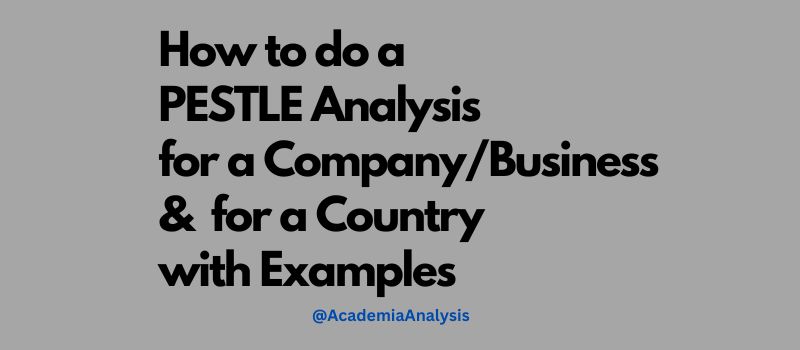Get the best advice on how to do a PESTLE analysis effectively with this step-by-step guide.
Learn everything you need to know about PESTLE analysis and why it’s important for strategic planning.
In this fast-paced business world, every company needs to be fully aware of its external environment to make strategic decisions.
That’s where PESTLE analysis comes in.
How to do a PESTLE Analysis? – General Steps with Examples
In this article, we’ll look at the 6 steps to do a PESTLE analysis and provide practical tips to help you make the most of this invaluable tool.

Step 1: Identify the factors
The first step in conducting a PESTLE analysis is to identify the factors that are relevant to your business or project.
For example, if you’re analyzing a software development company, you might consider political factors such as government regulations on privacy and cybersecurity, economic factors such as the availability of venture capital, social factors such as changing consumer demands for mobile applications, technological factors such as advances in artificial intelligence, legal factors such as patent laws, and environmental factors such as the carbon footprint of data centers.
Step 2: Research the factors
Once you’ve identified the factors, you need to research their impact on your business or project.
This can involve gathering data from a variety of sources such as news articles, industry reports, government statistics, and academic research.
It’s important to analyze both the current state of the factors and their potential future impact.
For example, you might analyze how a pending trade agreement could affect your supply chain or how changing consumer preferences might require new product development.
Step 3: Evaluate the factors
After you’ve researched the factors, you need to evaluate their significance to your business or project.
Not all factors are equally important, so you need to prioritize them based on their potential impact and likelihood of occurrence.
You might use a grid or table to rank the factors and visualize their relative importance.
For example, you might find that regulatory uncertainty is a high-impact, high-likelihood factor that requires immediate attention, while environmental concerns are a low-impact, low-likelihood factor that can be monitored over time.
Step 4: Analyze the interrelationships
One of the most powerful aspects of PESTLE analysis is its ability to show the interconnections between different factors.
For example, changes in political or economic factors can have ripple effects on social and environmental factors.
Analyzing these interrelationships can help you identify patterns and trends that might affect your business or project. It can also help you develop more holistic and integrated strategies that address multiple factors at once.
Step 5: Identify risks and opportunities
The ultimate goal of PESTLE analysis is to identify risks and opportunities that you can act on.
This requires a creative and strategic mindset that looks beyond short-term challenges and focuses on long-term value creation.
Based on your analysis, you might identify opportunities such as new markets, partnerships, or technologies that can help you grow and innovate.
You might also identify risks such as geopolitical instability, economic recessions, or environmental disasters that could threaten your business or project.
By taking action to address these risks and opportunities, you can improve your chances of success and create a sustainable competitive advantage.
Step 6: Monitor and adapt
PESTLE analysis is not a one-time event, but rather an ongoing process.
The external environment is constantly changing, and your business or project needs to adapt accordingly. It’s important to monitor the factors over time and update your analysis as needed.
You might set up a system to regularly scan the environment for new developments, or you might assign a team to oversee your PESTLE analysis.
By staying vigilant and adaptable, you can stay ahead of the curve and make informed decisions that drive growth and success.
How to do a PESTLE Analysis of a Company/Business
To perform a PESTLE analysis of a company/business, follow these steps:
- Firstly, examine the Political factors. This involves understanding the impact of government policies, regulations, and political stability on the organization.
- Next, consider the Economic factors, such as inflation, exchange rates, and economic growth patterns that might affect the company’s operations or profitability.
- Thirdly, identify the Sociocultural factors. These are the customs, lifestyles, and attitudes that characterize the society in which the company operates.
- Fourthly, consider Technological factors. Evaluate the impact of new technologies, digitization, and the rate of technological change on the company’s competitiveness.
- Fifthly, observe the Legal factors. This refers to the effects of the laws and regulations on the company’s operations.
- Finally, look into Environmental factors. These involve the ecological and environmental aspects that could affect the company’s operations and consumer preferences, such as climate change, environmental regulations, and societal emphasis on sustainability.
Remember, PESTLE analysis is a tool that helps in understanding the big picture of the environment in which the company operates and is an excellent starting point for strategic planning.
How to do a PESTLE Analysis of a Country
To perform a PESTLE analysis of a country, follow these steps:
- Political: Evaluate the current political scenario of the country. Analyze government stability, corruption levels, regulations, and tax policies.
- Economic: Consider economic factors like inflation rate, interest rates, exchange rates, and economic growth patterns.
- Sociocultural: Study the social and cultural aspects such as population growth rate, age distribution, career attitudes, and emphasis on safety.
- Technological: Assess the technological advancements of the country. Look at the level of technology integration, access to technology, infrastructure, and technological incentives.
- Legal: Examine the country’s laws and regulations. This includes labor laws, business operations regulations, health and safety regulations, and copyright laws.
- Environmental: Review the environmental factors like weather, climate, and climate change. Consider how these factors could affect certain industries.
Remember, PESTLE is a tool for understanding the ‘big picture’ of the environment you are operating in or planning to enter. The results can be used to take advantage of opportunities and to make contingency plans for threats when planning your organizational strategy.
Conclusion
In summary, PESTLE analysis is a powerful tool for any business or project that wants to navigate a complex external environment.
By following the above steps we’ve outlined, you can conduct a comprehensive analysis that helps you identify risks and opportunities, prioritize strategic initiatives, and adapt to changing circumstances.
Whether you’re a startup entrepreneur or a seasoned executive, PESTLE analysis can help you make informed decisions and create a sustainable competitive advantage. So, go ahead and master the art of PESTLE analysis today!
Reference links:
⇒ https://www.groupmap.com/portfolio/pestle-analysis
⇒ https://www.cascade.app/blog/how-to-do-a-pestle-analysis
Hope you understood how to do a PESTLE Analysis of a country and of a company/business with examples.
Thanks for visiting AcademiaAnalysis.com




